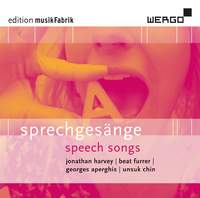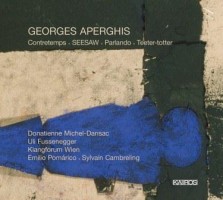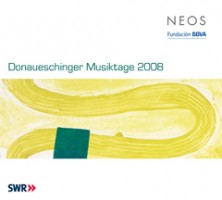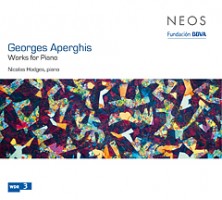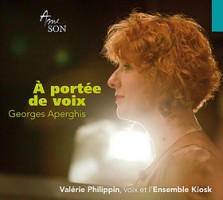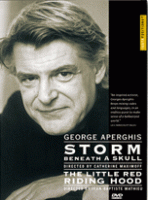Even Further Aperghis Sightings
|
Grant Chu Covell [May 2013.] “Sprechgesänge.” Jonathan HARVEY: Sprechgesang (2006-7)1. Beat FURRER: recitativo (2004-05)2. Georges APERGHIS: Babil (1996)3. Unsuk CHIN: Cantatrix Sopranica (2004-05)4. Peter Veale1 (ob, Eh), Salome Kammer2 (voice), Carl Rosman3 (clar), Anu Komsi4, Piia Komsi4 (sop), David Cordier4 (c-tenor), musikFabrik1,2,3,4, Peter Rundel1, Beat Furrer2, Sian Edwards3, Stefan Asbury4 (conds.). Wergo WER 6851-2 (1 CD) (http://www.wergo.de/). Georges APERGHIS: Contretemps (2005-06)1; SEESAW (2008)2; Parlando (2007)3; Teeter-totter (2008)4. Donatienne Michel-Dansac1 (sop), Uli Fussenegger3 (cbs), Klangforum Wien1,2,4, Emilio Pomárico1,4, Sylvain Cambreling2 (conds.). Kairos 0013222KAI (1 CD) (http://www.kairos-music.com/). Perhaps the world has come around to Aperghis’ way of thinking. Wergo positions Aperghis among similarly behaving peers, but Babil doesn’t sound like the Aperghis I thought I knew. Listening blindly, I might have put him down for Harvey’s Sprechgesang; however, Harvey asks for solo oboe / English horn and Aperghis, a clarinet. The notes provide a clue: “… Babil consistently avoids any linguistic sounds.” Indeed Babil plays more conventionally as Aperghis discards his customary patterns. The work evolves as a contentious conversation between soloist and 15-strong ensemble. Except for the calm conclusion, there’s little interaction between the two sides. Among Aperghis’ fellow travelers on the musikFabrik disc, the Harvey twists the oboe with multiple inflections. Associations are inevitable as the oboe squawks like a duck, with the rest of the ensemble following suit. Furrer drills soprano Kammer with a high-voltage German script. Requiring three vocalists (Anu and Piia are twins), Chin’s polystylistic cantata slithers to an absurdist Perec text. I mostly revert to the Harvey rather than endure the Chin in its entirety. The Kairos release showcases the frenzied insistence and the bolting rhythms I expect with Aperghis. In Contretemps Michel-Dansac must patter quickly and scream in her highest octave, as the ensemble cavorts with similar gestures in extremis. You will barely decipher the coloratura’s “crazy, crazy.” SEESAW and Teeter-totter ought to be related. Both stock up with instrument pairs. In SEESAW: two each of flutes, clarinets, pianos, violins, violas and cellos with one each sax and double bass; in Teeter-totter: two flutes, clarinets, cellos, pianos and percussionists, and a single sax, French horn and doublebass. These are violently kinetic pieces, the instruments hissing and spitting like cornered animals. SEESAW insinuates a greater deal of roughhousing with fewer melodic shapes. Teeter-totter starts with metallic scraping sounds. It’s as if all the pairs counteract to create noise instead of intelligible gestures. Parlando is a virtuosic double bass solo written for Fussenegger. Within its 17 minutes the soloist must juggle two staves and climb into the stratosphere via microtones. The booklet contains a great photo of Aperghis in his studio, filled with posters, paper and tapes. “Donaueschinger Musiktage 2008, Vol. 2.” Arnulf HERRMANN: Fiktive Tänze (2008)1. Saed HADDAD: The Sublime (2008)2. Eduardo MOGUILLANSKY: Cire perdue (2008)3. Georges APERGHIS: Teeter-totter (2008)4. Bernhard GANDER: Beine und Strümpfe (2007)5. Ensemble Modern1,2, Frank Ollu1,2 (cond.), Klangforum Wien3,4,5, Emilio Pomárico3,4,5 (cond.). NEOS 10942 (1 SACD) (http://www.neos-music.com/). Georges APERGHIS: À Tombeau Ouvert (1997); Les Secrets Élémentaires (1998); Printmusic (2001); Pièce pour jeunes pianistes (2004); Simata (1969). Nicolas Hodges (pno). Neos 10912 (1 SACD) (http://www.neos-music.com/). Aperghis is the most senior by far on the NEOS Donaueschinger 2008 release (from a three-disc set documenting that year’s happenings, these five premieres were recorded on Oct. 18). Perhaps the younger folks (Herrmann, Gander) are learning about simplification and instrumentation. Haddad’s The Sublime dares to start quietly as steel drum and harpsichord rouse the ensemble. Klangforum Wien’s first recorded stab at Teeter-totter takes 14:40. It’s easier to hear the details on their later 13:55 Kairos take (recorded in 2009). I can’t tell whether it’s faster or the Kairos release employs a revision. Piano does seem an odd choice for Aperghis. It can’t quite be made to breathe like a singer or animal. However, Hodges presents characteristically fidgeting and energetic music. According to the notes, À Tombeau Ouvert refers to a particularly reckless driving style. The work speeds without concern. Les Secrets comprises 13 obsessive epigrams, each limited, like marginalia, to a narrow range of notes or gestures. Printmusic also sticks to a restricted tessitura – a constant Morse code of chords in unsteady rhythms, Satie on amphetamines. There are jazzy sections, but given the haphazard repetitions, any resemblance to other music is coincidental. The piece for young pianists could fit among the Les Secrets series except for its ternary form and apparent simplicity. Simata is Aperghis’ first major solo piano work (a busy gap ensued before the second, À Tombeau Ouvert). Hodges’ version uses ring modulation instead of Cageian preparations, recalling distortions typical of earlier decades’ works. Aperghis’ exuberance is in great evidence. Like twisted and dissonant minimalism, sections randomly tumble for extended periods. An unexpected Romantic episode, like a treacly 19th-century poem, arrives towards the end. “À portée de voix.” Georges APERGHIS: Calme plats (1995)1; Dialogue amoureux (1985)2; Simulacre II (1991-95)3; Rire Physiologique (1982)4; Monomanies (1991)5; Fidélité (1982)6; Pub (2002)7. Valérie Philippin1,2,3,5,7 (voice), Jean-Philippe Causse4 (voice, pno), Ludovic Montet2,3,4 (voice, marimba), Aurélie Pichon3 (clar), Aurélie Saraf6 (voice, harp). Ameson ASCP 1019 (1 CD, 1 DVD) (http://www.ameson.fr/). Catherine MAXIMOFF: Georges Aperghis: Storm Beneath a Skull (2006). Jean-Baptiste MATHIEU: Georges Aperghis: Little Red Riding Hood (2006), L’Ensemble Reflex. Idéale Audience DVD9DS18 (1 DVD) (http://www.ideale-audience.com/). Philippin escorts a troupe of instrumentalists / vocalists through Aperghis’ demanding theatrical works. A non-native French ear will miss the meaning but acknowledge the colorful and potent atmosphere. This can’t be background music: Small doses permit easier realization of just how acrobatic everyone must be. Philippin offers three solo voice works. The ten Monomanies, written for her, set 16th-century French poetry whose wordplay and alliterations seem surprisingly modern. Nos. 9 and 10 are duets, here multi-tracked. The five parts in the Calme plat series reveal subtle, interior moods. Two pieces in Pub infuse advertising slogans with unexpected emotion. While Philippin seems well-suited to these pieces, I find that she takes too similar a tone, consequently blurring the music’s distinctions. The small chamber works are discomfiting. Despite the tight synchrony we expect from lovers, the rather unromantic two-voice Dialogue amoureux seems more like birds twittering. A marimba enters abruptly in Simulacre II, and then a clarinet, to form a trio with the singer. In the baritone plus piano duo, Rire physiologique, the vocalist taunts the pianist with all types of laughter. Aperghis specifies every aspect of the vocalizations. Nothing is spontaneous despite the effect. Fidélité is a disturbing quarter-hour for vocalizing female harpist and a silent male onlooker. The harpist navigates through a variety of responses to being observed. A concert performance concludes with the voyeur leading her offstage. Ameson’s DVD offers Les sept crimes de l’amour for trio (clarinet, voice and percussion, with optionally interspersed interludes here executed by two additional vocalists), Pub II, Simulacre II, Dialogue amoureux, and an interview with Philippin. Distracting vertiginous wipes make Dialogue amoureux hard to follow. Sept crimes contain equal parts stage directions and music. Rather than a story, we have aftermaths and possibilities. Visuals clarify Aperghis’ athletic demands. Ameson shares finished products. Maximoff’s Georges Aperghis: Storm beneath a skull pulls back the curtain onto Aperghis’ precision Utopia. The composer appearing calm, we get to see several Aperghis regulars at work or discussing the labors involved. Jean-Luc Fafchamps and Jean-Luc Plouvier navigate the two-piano Alter-Face with much busying and synchronization for a lightly textured surface. I wish we saw more of Françoise Rivalland and Sonia Wieder-Atherton in Profils (2001) for zarb and cello. Donatienne Michel-Dansac and Lionel Peintre show us that the exhausting multi-movement solos Récitations (1982) and Jactations (2002) require multiple personalities. Peintre describes the latter as a “monster out to get me.” While Philippin seems assured and sedate, there is much to be said about Michel-Dansac and Peintre’s sweating and writhing. Scenes of Avis de Tempête reveal an abundance of technology, with the climbing and whirling vocalists wearing or holding cameras for projections on the surrounding screens. Little Red Riding Hood is a 42-minute, tightly scripted action with choreographed musicians. The players with their instruments (violin, clarinets, saxophone, tuba) huddle and cavort around an upright piano. Language differences notwithstanding, the flow seems purposefully muddled, especially as the musicians’ preparations appear to be part of the theatre. Where does the script start and end? No question about it, we need more DVDs of Aperghis’ work. Avis de Tempête would be first on my list.
[More Grant Chu Covell]
[Previous Article:
Eastern Kingdom in the Midwest]
[Next Article:
A Single Breath: Beethoven’s Last Three Piano Sonatas]
|
